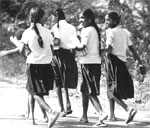Our country, our mess
 for the second time, I would like to draw attention to Social Watch , the annual report on social development presented by an informal network of international non-governmental organisations ( ngo s). This "social watchdog' appears to be quite successful in tracing whether governments fulfill promises they so elegantly make during United Nations conferences or in their ambitious five-year plans.
for the second time, I would like to draw attention to Social Watch , the annual report on social development presented by an informal network of international non-governmental organisations ( ngo s). This "social watchdog' appears to be quite successful in tracing whether governments fulfill promises they so elegantly make during United Nations conferences or in their ambitious five-year plans.
Published in March 1997, Social Watch reports on social development in 25 countries. And among them, is India. Let's take a quick look at this nation's status. Indian spending on social services as education, health, welfare, housing and community amenities comprise almost 25 per cent of the national budget and have a tendency to slacken. The assignation to the social sectors has diminished compared with other sectors in recent years, according to the authors Jagananda, Sundar N Mishra and R Gopa Kumar. This is largely due to India's high payment of interests (40 per cent of the total non-development spending) and the comparatively high spending on defence: about 22 per cent of the national budget. The authors have given a rather distressing picture of the state of basic conditions in India.
Take sanitation and drinking water: although the current situation has improved, only 29 per cent of the population have access to adequate sanitation (14 per cent rural and 70 per cent urban). One million children die annually from causes related to drinking unhealthy water. Or take education: the government spent 2.3 per cent of the budget in 1995-96 on education. As a result, 30 per cent of the children between 6 and 14 years of age (amounting to a staggering 55 million) have never been registered in a school. "In many parts of India, especially in the Northeast, the school schedules are not even known and the social responsibility and pressure which guarantee that teachers actually go to work does not exist. The Dalit, tribal and Muslim children in rural India do not normally attend formal school. And if girls go to school it is only to get free uniforms or lunches as they generally look after their siblings or help their mothers,' comment of the authors.
India has made serious and long-standing attempts to make basic health services available for all. Indeed, this has been realised for 85 per cent of the people. But this still leaves 136 million people without access to any of the health services. Four of each five women suffer from anaemia, which is the highest rate in the world. Only one in every three mothers receive qualified help at the moment of giving birth, which leads to the death of 1.2 million women every year. Of the 26 million children born each year, 2.3 million die even before they are a year old. Of the survivors, 1.2 million die before their fifth birthday. More than 90 per cent of these deaths could have been avoided through access to clean drinking water, adequate nutrition and basic health services.
Maybe you remember the 20/20-initiative? This initiative, adopted during the World Summit for Social Development in 1995, seeks a mutual contract between donor and recipient countries: 20 per cent of the official development assistance and 20 per cent of the public expenditure will be used on basic social services. It is a rough guideline, that serves to highlight the necessity of universal basic social services. In India
Related Content
- Directions under Section 16(5) of the Food Safety and Standards Act, 2006 regarding operationalisation of amendment regulations regarding revised standards for milk and milk products and certain restriction on sale of cream
- ACREX India 2014: A sustainable foundation for Future India
- ACREX India 2014 looks to reduce India’s Infrastructure carbon footprint by over 40%
- Crores to gamble
- Waste-to-energy gets fund boost
- Pall of economic gloom and policy paralysis hits India
